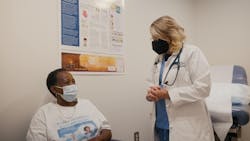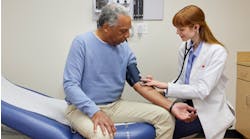Last fall, leaders at Lifepoint Health, a Brentwood, Tenn.-based nationwide network of acute-care hospitals, rehabilitation hospitals, and behavioral health hospitals, implemented an at-home patient monitoring service powered by its operational partner, the New York City-based Cadence, which supports integrated health systems delivering accountable care, through technology solutions. Lifepoint encompasses 60 acute-care hospitals, 30 rehab centers, 30 behavioral health units, and around 250-260 other sites of care. Cadence is also partnering with seven other health systems on advancing care management with its tools.
Recently, Healthcare Innovation Editor-in-Chief Mark Hagland spoke with Chris Frost, M.D., chief medical officer of Lifepoint Communities, the division of Lifepoint Health that has oversight of Lifepoint Health’s national quality program, focusing on reducing patient harms and enhancing patient safety, while also advancing hospital-physician partnerships. Among other areas, Dr. Frost oversees care management in the health system, and efforts to reduce unnecessary clinical variation. He and his colleagues focus on data and analytics, quality-based process improvement, and change management, working with physicians to explain the why and get their buy-in for needed adjustments in clinical practice. Below are excerpts from that interview.
Tell me about the background to this activity?
LifePoint is Cadence’s founding partner: we launched in August 2021. Our primary goal was improving patient outcomes. Two years later, we’ve got over 3,000 actively enrolled patients, across congestive heart failure, hypertension, and diabetes. With that deliberate work, we’ve been able to achieve a nearly 20-percent decrease in patients with elevated blood pressure, esp. systolic, and a 30-percent reduction in blood sugars for our diabetics. We ascribe to the “crawl-walk-run” model, and in that regard, we’re at the “walk” stage.
The outcome that floors me ais that, through our work with Cadence, we’ve seen a 550-percent increase in CHF patients seeking GDMT—Goal-Directed Medical Therapy. GDMT includes five classes of medications that you want your CHF patient to be on, as they’re deemed eligible. We’ve all been to the doctor. You have a patient visit, and you have to wait for an office visit for medications to be adjusted or for new medications to be adjusted. But our work with Cadence has helped to accelerate that process.
CHF is a really hard disease to get improved outcomes on, correct? It’s both one of the most intense chronic illnesses for a patient to experience, and one that is particularly resistant to improved outcomes. And health status improvement usually requires the active participation of family-member caregivers, correct?
Yes, your characterization of the disease process and involvement of others is so spot on. So it’s a combination of medication management and lifestyle modifications, and sometimes, cardiac rehab programs, etc. And where Cadence helps is around blood pressure management and monitoring heart rate and rhythms and the ability to very tightly manage daily weight fluctuations, which are often an indicator of the amount of fluid accumulated, which in turn puts pressure on the heart. Historically, the patient might relay the information to the physician and the physician would get data points every month or two. With Cadence, we have daily flow of data that helps in patients’ care management. And family members often feel strain. So one of the most common pieces of feedback we get is the piece of mind that family members feel as their family member is being taken care of. One gentleman was telling us, “One of the impacts is that it’s improved my mental health.” And his wife said, “Oh, and mine, too!” It speaks to peace of mind for family members.
Continuous monitoring of patients living with chronic illnesses was a dream 30 years ago; now we can do it.
Yes, now we can do it. And the technology is here, but has to be supported by evidence-based clinical guidelines, and by a clinical team that can intervene as needed. So, “Mr. Smith, your weight has just gone up five pounds, let’s talk.” And that might lead to dietary changes. And has to be supported by the family member caregiver.
Technology can give us a comprehensive view of the patient, and it can give us such views of patients at scale, correct?
Yes. After two years and 3,000 patients enrolled, we do believe that that’s the tip of the proverbial iceberg. Remember that we have 250 non-inpatient sites of care. And we’ll continue always at the discretion of the shared-decision-making of the physician and patient, and will continue to scale around CHF, hypertension, and diabetes. And COPD will be one of our next areas of focus. And in addition, we’ve pulled in our population health team, which works with our accountable care organizations. There’s another opportunity to impact both outcomes and the cost of care.
What have been the biggest lessons learned so far on this journey?
This project has really enhanced the effectiveness of the care team. Doing this requires not just one physician and a few nurses, but an entire comprehensive team. And when we talk with the doctors about this, their first concern is how patient outcomes will be impacted; and the second is how it might impact their staff’s clinical workflow. And I’ll be honest: I was concerned it might negatively impact workflows. But team-based care management, evidence-based data support, work. The doctors tell us there are fewer phone calls, there’s decreased workload for the staff, even as the outcomes improve. And what’s interesting is that only 2 percent of the patient’s we’ve been care-managing have required escalation to the primary care physician. That speaks to the clinical prowess and the incredible validity of the evidence-based guidelines that are being wielded through that platform.
What should healthcare IT leaders, including CIOs and CMIOs, know about this?
The thing that’s made us—Cadence and Lifepoint—successful is that there hasn’t been an over-focus on technology or even on evidence-based guidelines without a compassionate care team. Instead, success requires attention to all three legs of the stool: it’s leveraging technology with evidence-based guidelines, with a care team that cares about the patients they’re interacting with.


